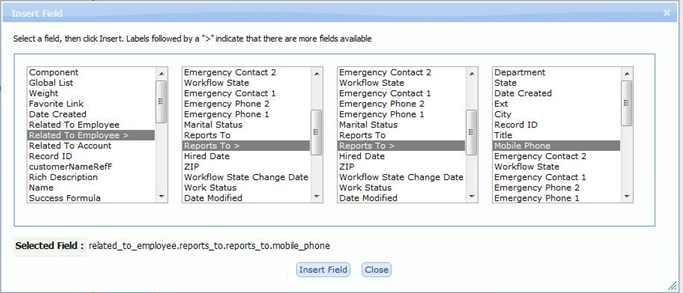Rule Actions
From AgileApps Support Wiki
Revision as of 13:58, 12 March 2018 by imported>Aeric
- Selecting actions
- Select the action to perform when Rule conditions are satisfied.
(Possible actions are listed below) - As with conditions, additional options appear, depending on the action you select.
- Click [Add More] to specify additional actions.
- Available Actions
Set Priority
- This option appears for Cases. It allows the priority to be changed--for example from "P2" to "P1"
- Trigger Rules - This option enables the firing of Case-update rules.
Set Status
- This option appears for Cases. It allows the status to be changed--for example, to Closed
- Trigger Rules - This option enables the firing of Case-update rules.
Add Record
- Select an object to add a record to, and specify field values for the record:
- Do Not Trigger Rules - By default, Rules are enabled when adding a record. This option disables them.
- Use the Field Chooser to select object fields.
- For each field, use the Formula Builder to specify the field value.
Update Record
- Modify data in the current record
- Trigger Rules - This option enables the firing of record-updated rules.
- Use the Field Chooser to select fields to modify -- including fields in a record targeted by a Lookup field in the current record, or fields targeted by Lookups in those records, and so on, as shown here:
- For each field, use the Formula Builder to specify the field value.
Add Note
- Add a note to the current record.
- Enter text for the note in the text area
- Use the field selector to add record variables
- Example: This note is for $user.full_name.
Assign to User
- Determine the new owner of the record. The options are:
- Logged-In User - The user who is running the application when the rule is triggered. (Not the designer who created the rule.)
- Note: This value is undefined for a record that is created or updated by a Process.
- Pick a User - A lookup field appears. Use it to select a specific user.
- Select a User Field - The [Choose User] button appears. Use it to select a Lookup field that targets the Users object.
- That field can be defined in the current record or in the record the Lookup points to, up to 5 levels deep.
- For example: Owner > Reports To > Reports To_id assigns the record to the current owner's second-level manager.
- Use an expression - Use a combination of fields and expression operators to choose the user to assign to.
- This feature is commonly used to specify if-then logic, or to find a User field defined in an associated record.
- For example, for Case with a Lookup to an OrderItem, the Rule might choose OrderItem > Order > Customer > Agent in Charge_id
- That setting would assign the case to the "troubleshooter" who handles issues raised by that customer.
Assign to Team
- Determine the group the record goes to, so members of the group can claim it.
Send Email
- Send a message, optionally using an Email Template
- Note:
Do not choose a template that includes a JSP page as an attachment.
Learn more: JSP Attachment DeprecationCreate Task
- Create a new task and specify its settings:
- Owner - Who should perform the task.
- Subject - Title of the task.
- Duration - How long it is expected to take.
- Do not notify - A notification is sent automatically, unless this box is checked.
- Description - Description of the activity to perform.
Use the Record Variable selector to add references to record fields, dates, times, user data, and company information.Start Process
- Automatically initiate a Process.
Note: One you start a process, you cannot stop it half way and resume it from that point at a later time. A process always restarts from the first step.
Start DBO Process
Select this to communicate with the Integration Server and fetch a list of all the process models that are created in the Dynamic Business Orchestrator (DBO). DBO is a separate application and is available to you as part of the Integration Server package. DBO as an application is primarily used for business process management.
Change Process Status
- Set the status of the process.
Execute Rule Set
- Chain to a different Rule Set, and execute those Rules. Come back to this set when done, and resume processing with the next Rule.
Invoke Method
- Learn more: Invoke a method in a Java Class
Execute Web Service
- Select a Web Service, and specify the mappings for its input and output parameters.
Return Process Decision Value
- This action can be taken by a Rule in a Rule Set whose return type is "Process Decision Value".
- The specified value becomes available for testing in a Process Decision Switch.
- When this action is taken, rule processing stops.
- Learn more: Rule Set Properties
Return Step Owner
- This action can be taken by a Rule in a Rule Set whose return type is "Step Owner".
- Select the User, Role, or Team who will be the assigned the task associated with a Process step.
- When this action is taken, rule processing stops.
- Learn more: Rule Set Properties


